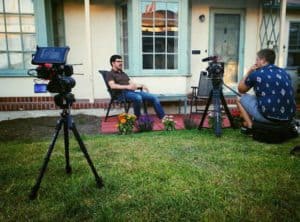Seeking to help organizers draw more attention to their projects, Indiegogo has revealed tips on how to get the press to cover campaigns.
The crowdfunding platform stated:
“We want every campaign on Indiegogo to be successful. Our team is constantly researching the best ways for you, the campaigner, to find success and reach your goal. We always recommend taking the time to build a promotion strategy for your campaign, focusing primarily on rallying your community both online (via email and social media) and offline (via events, phone calls, or meetups).
“In addition to email and social media outreach, your strategy should also include a way to share your campaign with the media. Media coverage gives your community something to Tweet and post on Facebook, and publicly validates your campaign. Further, research has shown that posting press mentions to social media leads to more contributions.
“Developing an effective media strategy will ensure that you aren’t wasting too much time contacting the press and can focus on raising funds by email and social media.”
Check out Indiegogo’s 7 Tips to Get the Press to Cover Your Crowdfunding Campaign below!
1. Pitch your story, not the campaign.
Crowdfunding campaigns are everywhere, but your story is unique. As Alison MacAdam of NPR says, reporters “want to know the whole story,” not just that you’re running a crowdfunding campaign. She explains:
“Journalists have no interest in doing your PR for you. That’s why you need to offer a broader value proposition. What story can the journalist tell that is bigger – more universal – than your campaign?”
Therefore, when writing your pitch, share your struggles and triumphs. How are you overcoming obstacles to reach your idea? Alison suggests:
“A good story has to have a compelling question. Not ‘Here’s a person, here’s a place.’ Instead, is your story a journey? Is there a trajectory? Is there some forward motion that makes me want to stay through the end because you’re going to reveal something or make me learn something?”
Your campaign should be integrated as a thread in the narrative of your story.
2. Target local media first.
 Media breeds media. When you pitch your story to larger media outlets, they’ll look to see who else has covered it. Since larger media doesn’t have local boots on the ground, they look to local media for interesting leads. If you have local or smaller media coverage, then larger media will consider covering you too.
Media breeds media. When you pitch your story to larger media outlets, they’ll look to see who else has covered it. Since larger media doesn’t have local boots on the ground, they look to local media for interesting leads. If you have local or smaller media coverage, then larger media will consider covering you too.
When Karyna Laroche ran her Indiegogo Life fundraiser Trip of a Lifetime!, her initial media strategy didn’t work. She shared:
“I started targeting media with the greatest viewership, then I focused on local. If I did it again I would do the reverse. Start locally, then go broader.”
The greatest impact came from being featured on her local news station’s 6 o’clock broadcast. Donations poured in as a result.
“I reached my goal exclusively through local donations. I shouldn’t have wasted my effort on national news. People relate to a local story.”
3. Research journalists to determine who you should contact.
Instead of contacting tons of journalists, target those who have covered topics related to your campaign and your story. They’re more likely to be interested in your campaign, and want to cover it. While reading articles and Tweets relevant to your story, take note of who is writing and commenting on this topic.
 Then, identify each journalist’s preferred mode of contact and communication, and use it to contact them. For example, many journalists are very active on Twitter, and respond quickly to Twitter direct messages or @ mentions. That’s where Holly Moore of USA Today prefers to communicate, as well as search for stories. She explains:
Then, identify each journalist’s preferred mode of contact and communication, and use it to contact them. For example, many journalists are very active on Twitter, and respond quickly to Twitter direct messages or @ mentions. That’s where Holly Moore of USA Today prefers to communicate, as well as search for stories. She explains:
“Most ideas come from social— that’s where conversations are already taking place.”
Campaigner Ryan Moore (no relation to Holly) called Twitter direct message “the most amazing way to contact somebody” while he was running and publicizing his campaign A Year Without God: The Documentary.
You can use the site ANewsTip to find relevant journalists by what they Tweet.
4. Reach out to influencers, not just media.
Target major influencers with large social media followings who are interested in your campaign’s topic, and contact them via social media. They may share your campaign with their followers.
For example, Amy Poehler’s Smart Girls featured the campaign Miss Possible: Dolls to Inspire Across Generations on their Facebook page. This one Facebook post brought in over $10,000 to the campaign in one day!
5. Pitch earlier rather than later.
 Start pitching your story as soon as your campaign launches, or even just before. Certain publications are published less frequently (weekly or monthly, for example). It will take longer for these types of publications to be able to cover your story. And if a daily publication is interested, they may have to delay your story due to breaking news. Therefore, to ensure your story is shared while your campaign is active, pitch as early as possible!
Start pitching your story as soon as your campaign launches, or even just before. Certain publications are published less frequently (weekly or monthly, for example). It will take longer for these types of publications to be able to cover your story. And if a daily publication is interested, they may have to delay your story due to breaking news. Therefore, to ensure your story is shared while your campaign is active, pitch as early as possible!
Also, take events into consideration for your timeline. Are there major upcoming events that the media will cover, like holidays, elections, or sports finals? If so, send your pitch even earlier, way before these events.
6. Include high-resolution photos and contact information in your pitches.
Save journalists some time. Give them everything they need to tell your story, including high-resolution photos, your campaign’s link, and several ways to contact you, such as an email address, phone number, and Twitter handle.
 For example, Ryan styled his pitch to publicize A Year Without God: The Documentary after a Wikipedia page, limiting it to one page and adding photos and a poster for his film.
For example, Ryan styled his pitch to publicize A Year Without God: The Documentary after a Wikipedia page, limiting it to one page and adding photos and a poster for his film.
If you’re pitching the press once your campaign is live and receiving contributions, you should include data from your Indiegogo dashboard, as well as any past press you’ve received, so that journalists will have plenty of information to include in their features.
7. Reach out again every time you hit a campaign milestone.
A successful campaign may be more interesting to certain journalists than a brand-new campaign. Therefore, every time your campaign reaches a certain amount of funds raised or a certain number of contributors, pitch the same journalists again. Examples of milestones may include getting your local press to cover your story, reaching 25%, 50%, or 100% of your campaign goal, or a Tweet from a celebrity.
David Heath of BOMBAS: Better Socks. Better World. Bee Better. got more media mentions using this tactic.
“With every milestone achieved, we reached out to the same media list. For some we didn’t hear back at $20K, but we heard back at $100K.”
The platform then added:
“With a strategy in place and these 7 tips to guide you, you’re more likely to get the press interested in your story. All it takes is one press mention for your campaign to gain traction and reach more media outlets. Remember that although having an effective media strategy is key, it’s important to balance your time between press, email, and social media. Next steps: download our media outreach worksheet, and get to work implementing these techniques!”
Have a crowdfunding offering you'd like to share? Submit an offering for consideration using our Submit a Tip form and we may share it on our site!


